Dumb cane (Dieffenbachia) plants are low maintenance and don’t require any special care. Once you understand the growing requirements, you’ll be able to keep your plant healthy and thriving.
Though they aren’t super fussy houseplants, it’s important to understand exactly what they need so you can enjoy the lush foliage for many years to come.
In this complete care guide, I’ll show all you need to know about how to grow Dieffenbachia. You’ll find information about water, soil, light, fertilizer, pruning, propagation, pest control, and much more.
Quick Dieffenbachia Care Overview
| Scientific name: | Dieffenbachia |
| Classification: | Tropical plant |
| Common names: | Dumb cane, Dumbcane |
| Hardiness: | Zones 10+ |
| Temperature: | 65-80°F |
| Flowers: | Green, blooms spring-summer |
| Light: | Full to partial shade, bright light indoors |
| Water: | Allow soil to dry slightly, do not overwater |
| Humidity: | Average to high |
| Fertilizer: | General purpose plant food spring-summer |
| Soil: | Fast-draining, fertile soil |
| Common pests: | Spider mites, thrips, mealybugs |
Information About Dieffenbachia (Dumb Cane)
Dieffenbachia is a very common indoor plant that is prized for its beautiful foliage and simple care requirements. It’s in the Araceae family of plants, and is native to parts of Mexico, the West Indies, and South America.
It earned the nickname, “dumb cane”, because there is a chemical in the sap that can cause temporary loss of speech if any part of the plant is chewed or eaten.
Though they originate from the tropics, they make excellent houseplants because they can quickly adapt to growing indoors.
Different Types Of Dieffenbachia
There are lots of different species and cultivars out there these days, and they’re all gorgeous. You can find dumb cane plants in various sizes and foliage colors too.
Some have large leaves, and can grow to be several feet tall, while others stay much smaller and more compact. The leaf colors vary by type, ranging from dark or bright green with whitish stripes or spots, to almost white leaves with dark edges.
Common varieties you may come across are Seguine, Compacta, Maculata, Golden Sunset, Camilla, or Amoena. Here’s a great list with more options.
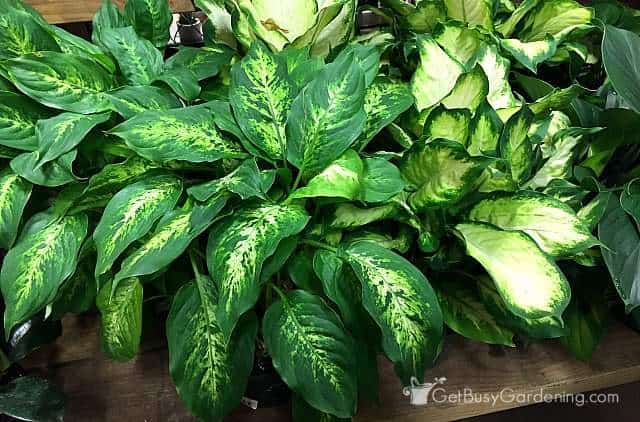
Toxicity
All parts of the Dieffenbachia plant are poisonous when chewed or ingested. According to the ASPCA website, it is also toxic to cats and dogs.
So, if you have animals or small children, then it’s best to keep this plant out of reach, just in case. Check out my list of pet friendly houseplants instead.
Flowers
Though they are best known for their lush foliage, dumb cane plants can also bloom, but the flowers are small and insignificant.
The blossoms are green with a long, white spadix, and tend to appear in the spring or summer. They often blend in with the leaves, so you might not even notice them.
It’s also not very common for a Dieffenbachia to flower indoors. They need the perfect growing conditions, and it can be difficult to get it just right in the average home.
Where To Grow Dumb Cane
Once you bring home a new Dieffenbachia plant, you’ll need to know where to grow it. To have the best success, it’s very important to understand their hardiness and the ideal location.
Hardiness
Dumb canes are not tolerant of the cold, and they will only survive outside year-round in zones 10+. They can handle a very light frost, but if it drops below freezing, the plant will die pretty quickly.
These sensitive plants don’t do well in extremely hot, arid regions either, and prefer a mild, temperate climate. Since they’re so sensitive to any type of extreme weather, it’s usually best to just grow them indoors.
Location
If it’s warm and humid enough where you live, you can grow Dieffenbachia in your garden. Just be sure to choose a shady location where the soil is fertile and well-draining.
Indoors, put your plant in a spot where it will get plenty of bright, indirect light. If you want to move it outside during the summer, bring it back inside before the temperature drops below 60°F.
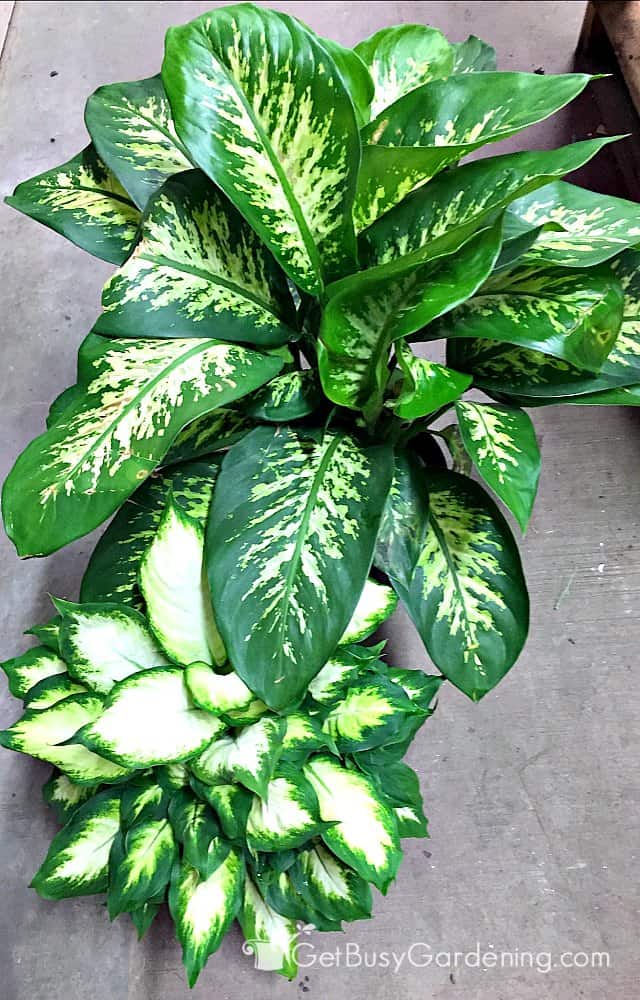
Dieffenbachia Care & Growing Instructions
Even though dumb canes are fairly self-sufficient, they do require some care from you to grow their best. Follow my detailed tips below to keep your plant healthy and thriving.
Water
Proper watering is a crucial part of Dieffenbachia care, and overdoing it is their #1 cause of death. They need consistent, even moisture, but don’t like to be overwatered.
Let the soil dry 1-2″ deep between waterings, but never let it get completely bone dry. Press your finger 2″ into the soil to check the moisture level before giving it more.
The type of water you use is important too. Dumb canes are sensitive to the salts and chemicals found in tap water, which can cause the leaf edges and tips to turn brown. So it’s best to use distilled or rainwater.
When it’s time, give your plant a good soaking until the water starts to run out of the drainage holes. Then allow the excess to completely drain from the pot. If you struggle with this, I recommend getting an inexpensive moisture gauge to help you out.
Humidity
Since they are from the tropics, dumb cane plants really like high humidity. Though they adapt well to lower levels, if it’s extremely dry, the leaf tips and edges can start turning brown.
So if yours constantly has brown leaves, tips, or edges, then try running a humidifier nearby or misting your plant to see if that fixes the problem.
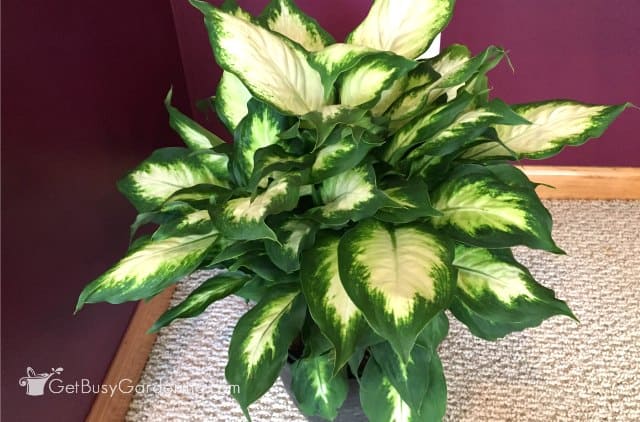
Light
Dieffenbachias are the perfect low-light houseplants because they like the shade, and direct sun will cause their leaves to fade or burn. But if it’s too dark, they’ll quickly grow tall and leggy.
Indoors they need bright, indirect light. A spot next to a sunny window, or an area where your plant will get filtered light through a curtain or blinds would be perfect. If you don’t have a bright room, then you could use a small grow light.
It also helps to rotate the plant once in a while to prevent it from reaching to one side as it grows taller. I rotate mine every time I water, or monthly (or whenever I remember).
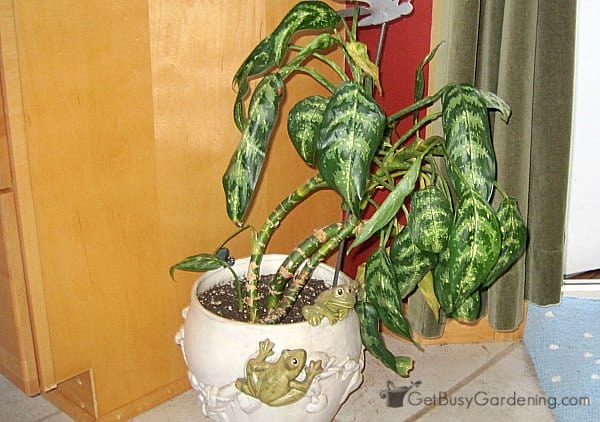
Soil
Dumb canes aren’t super fussy about the type of soil you use, any high-quality general purpose potting mix will work just fine. But they do prefer a porous and well-draining medium.
So, if you tend to overwater, then you’re better off using a fast-draining mix. Or you could add some perlite, pumice, or coarse sand to the potting soil to improve drainage.
Repotting
You don’t have to worry about repotting your Dieffenbachia very often, they don’t need it until they’re pot-bound.
You’ll know it’s time when you see roots coming out of the bottom holes, if there are more roots than soil in the container, or if you have to water your plant constantly to keep it from drooping.
Always use a container with holes in the bottom, and only go up one or two pot sizes. If you give it too much room, your plant may have a difficult time becoming established in the new container.
Related Post: When & How To Repot Houseplants
Fertilizer
Another great thing about dumb canes is that they can grow just fine without fertilizer. But they will benefit from being fed during the spring and summer, and it could even trigger blooming.
However, they are very sensitive to chemicals. Overuse of synthetic fertilizers can lead to brown leaf edges and tips, among other issues. So I highly recommend using an organic one instead.
Apply a diluted, liquid houseplant fertilizer or a compost tea monthly, or you can add slow-release granules once in the spring. Stop feeding in the fall and winter to let your plant rest.
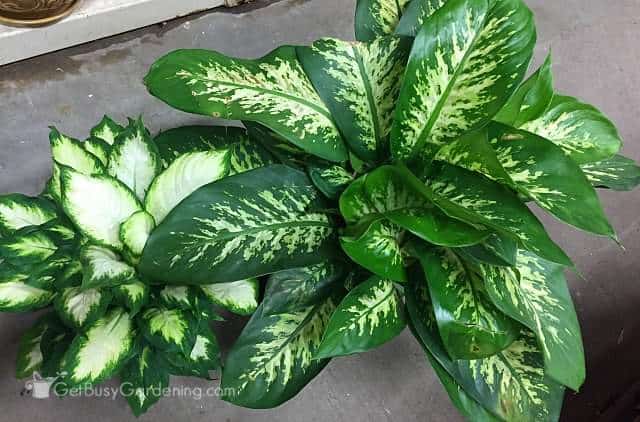
Pest Control Tips
It’s rare for a healthy Dieffenbachia to have problems with bugs, but sometimes spider mites, thrips, or mealybugs can attack them.
If you find bugs, begin treating your plant right away. My favorite product to use is neem oil. It’s a natural insecticide that’s very effective at controlling houseplant pests.
Organic insecticidal soap also works well to knock down an infestation quickly. I make my own by mixing 1 teaspoon of mild liquid soap per 1 liter of water.
Related Post: How To Get Rid Of Houseplant Bugs Naturally

Pruning
Pruning is an important part of Dieffenbachia care, and you should do it regularly. It helps to keep your plant tidy, compact, and healthy. Here are my tips:
- Remove dead or dying leaves and flowers at any time by simply cutting them back to the main stem.
- Trim off brown leaf tips and edges as necessary, following the natural shape of the leaf.
- Clip new growth at the tips every spring to prevent legginess, and encourage your plant to grow more compact and bushy.
- If your dumb cane has grown tall and leggy, you can top the plant, or cut it back anywhere on the stem. New leaves will form just below the spot where you made the cut.
Dieffenbachia Propagation Methods
You can propagate your dumb cane from either stem cuttings or by division. If there are several stems growing in the pot, you can separate them to make new plants.
Rooting cuttings can be a bit tricky. The key is to provide lots of humidity, and keep the soil moist but never soggy.
Take a stem cutting that’s at least 4″ long, and dust it with rooting hormone. Then plant it in a loose, porous soil mix. You’ll know it’s rooted when you see new leaves developing on top.
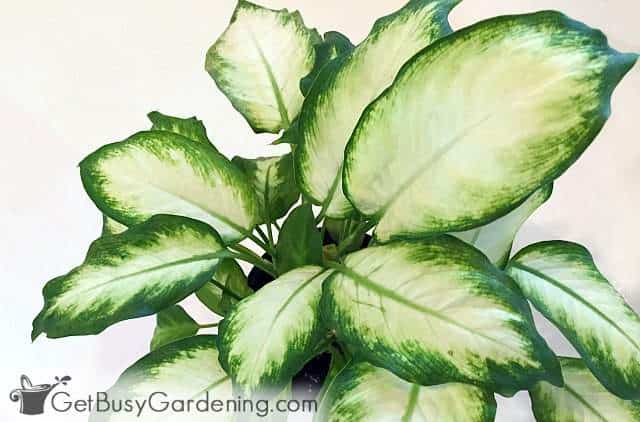
Troubleshooting Common Dieffenbachia Problems
The most frustrating part about Dieffenbachia care is when your plant is sick, and you don’t know why. Below are some of the most common problems you might run into, and tips for how to fix them.
Brown Leaf Tips Or Edges
Brown leaf edges and tips are usually caused by inconsistent watering, low humidity, or salt and chemical buildup in the soil from using tap water or synthetic fertilizers.
Crusty buildup on the top of the soil or around the inside of the pot are signs of overfeeding or too much salt/minerals from tap water. Switch to an organic fertilizer, and use filtered water or rainwater.
Drooping Leaves
When the leaves or the whole plant start drooping, it’s usually caused by over or under watering. But it could also be from exposure to cold or hot air, plant bugs, or transplant shock after repotting.
Leggy Dieffenbachia
Dieffenbachia naturally gets leggy over time, it’s their normal growth habit. But it can be worse if your plant isn’t getting enough light, so move it to a brighter location. You can also prune the tips regularly to encourage bushier growth.
Yellowing Leaves
It’s normal for the lower leaves to turn yellow or brown, and eventually die. Simply trim them off as needed. However, if several of them are yellow, or they aren’t on the bottom, then it’s probably overwatering, insufficient light, pot-bound roots, or bugs.
Inspect the leaves for any signs of an infestation, and then check the soil moisture level. It should never feel soggy or overly wet. If it’s not those things, then make sure your plant is getting bright, indirect light, and check to see if it needs to be repotted.
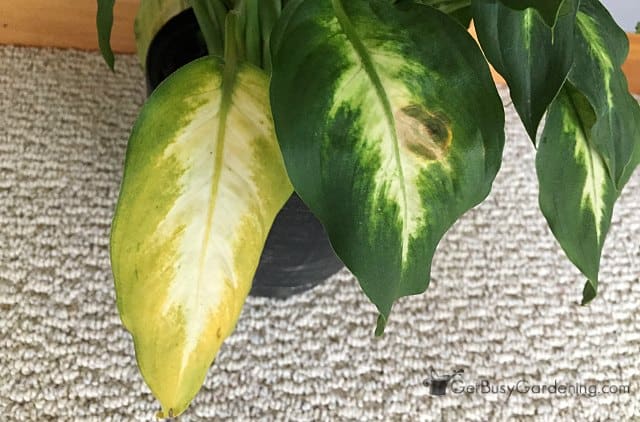
Now that you know how to properly take care of your Dieffenbachia, you’ll be able to grow these gorgeous houseplants for many years to come.
If you want to learn all there is to know about maintaining healthy indoor plants, then you need my Houseplant Care eBook. It will show you everything you need to know about how to keep every plant in your home thriving. Download your copy now!
Share your Dieffenbachia care tips in the comments section below.
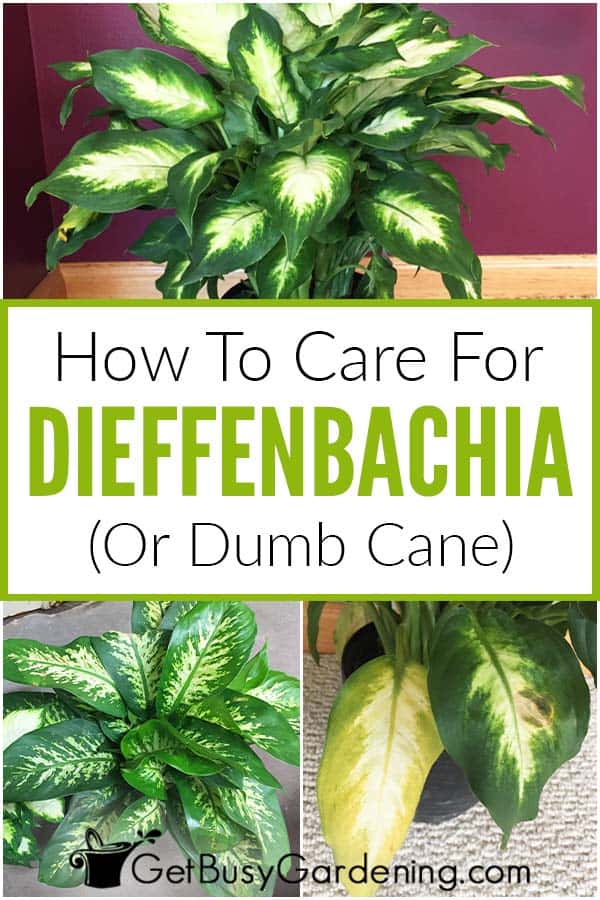
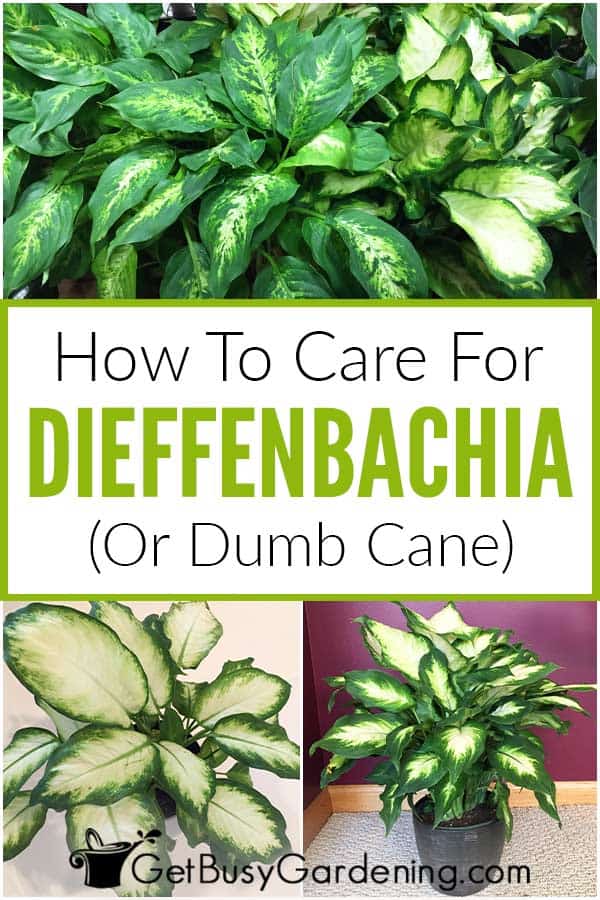

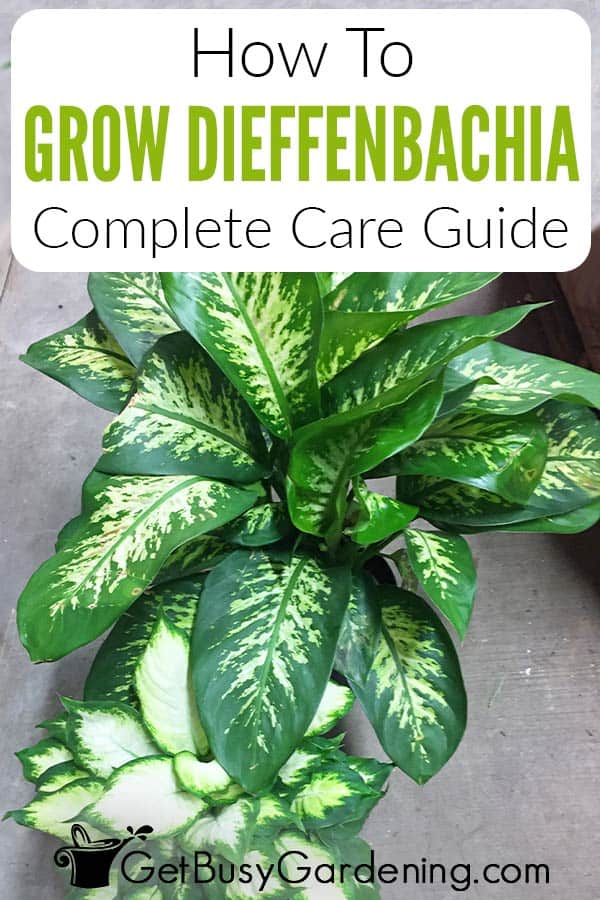

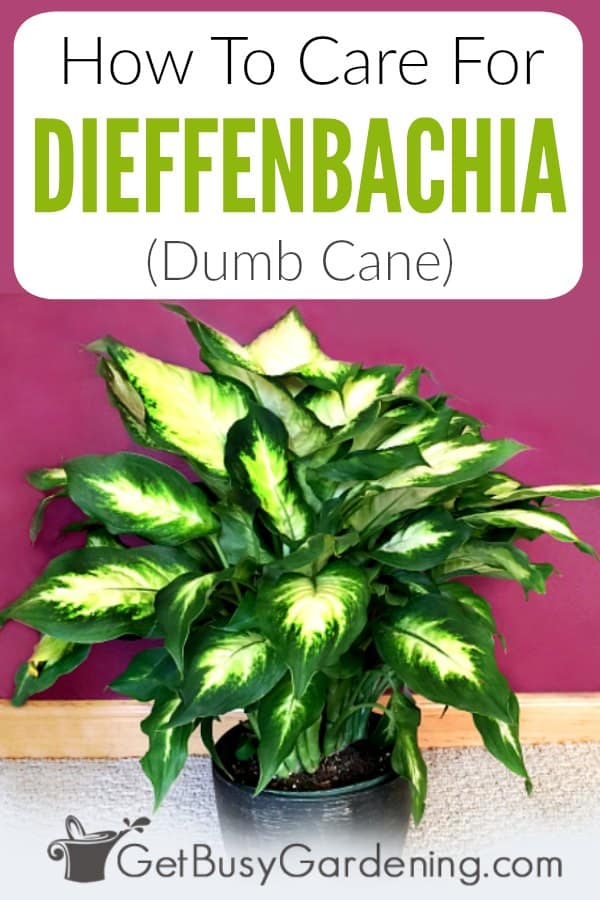
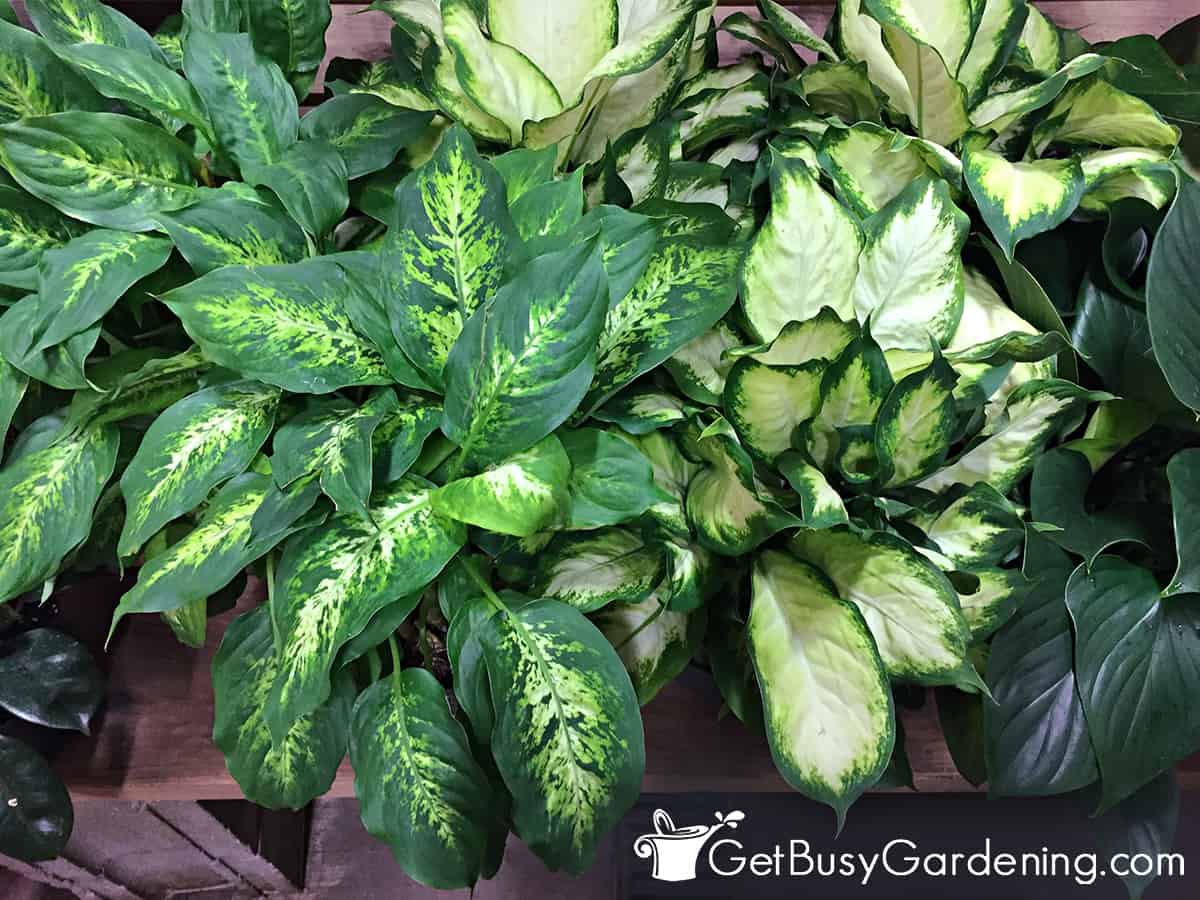



Molly Wilson says
I have a spotted Dieffenbachia that had large full, flat leaves when I bought it. Now it only produces smaller leaves and never as big as when I got it despite potting in a larger container than the garden center sold it in. I have lots and lots of new leaf growths but they always produce small to medium leaves and not the large flat leaves. What am I doing wrong? Also, I see a lot about pruning etc but for the life of me I can’t figure out where on the stem to actually cut it. Whenever I do trim, no new leaves come out, the stem just eventually turns yellow and mushy and I have to pull it off.
Amy Andrychowicz says
It sounds to me like your dieffenbachia is being overwatered. Small, stunted growth, as well as the stems turning yellow and mushy are sure signs that it’s getting too much water. This is a common problem if the new container you used it too large, or if there aren’t any drainage holes in the bottom. Stick your finger at least one inch into the soil to see how wet it is every time before you water. If it’s wet, then allow it to dry more before watering it again. See the section above titled “Dieffenbachia Watering Instructions” for more details.
Sandy says
Hi, I’ve had my dieffenbachia plant for a long time and was very crowded n the pot I had had it in for a long time so repotted it with fresh soil. Unfortunately when repotting it the tallest stalk broke off so I just cut both ends and put it in the soil hoping it would root but the stalk starting turning yellow so took that branch out of the. Pot…it didn’t have any roots on it so discarded it , now there is a fungus growing on the soil all over the top of the soil what do I do to save th rest of my plant?
Amy Andrychowicz says
Bummer, sorry to hear you’re having problems with your dieffenbachia. When fungus grows on top of the soil like that, it’s a sign that you’re overwatering. Stick your finger one inch into the soil to see how wet it is. Wait until the top inch is dry before watering again. To help get rid of the fungus, you can just scrape it off. You can also use a fan to help dry the top of the soil faster, which will help get rid of the fungus as well.
Terry Tannenbaum says
My dieffenbachia tend to grow to about 16 ft high in my family room but they are turning brown and drooping…I know there is a lot of iron in the water…because if I leave a cup of water, I will see a pink rim. Does this hurt the plant?
Amy Andrychowicz says
Yes, things like iron and other chemicals found in tap water can build up in the soil, and cause harm to plants over time. I recommend switching to watering your dieffenbachia with filtered water, distilled water, or rainwater.
Ginny Schena says
Super excited after reading this. Both of my dumb cane plants are blooming. One is strictly in water and the other is in a pot. I started feeding all of my houseplants regularly last year and have had lots of Christmas cactus blooming at different times of the year, as well as the peacefully
Amy Andrychowicz says
Wonderful! That’s so cool that your dumb cane is blooming, it’s obviously very happy with the fertilizer and care you’ve been giving it. Congrats on the other blooms too!
Vader says
I just moved and bought my dumb cane with me. I packed it in a large box but now the lower leaves are drooping. What can I do to help my plant for it is from my mother’s funeral.
Amy Andrychowicz says
It’s normal for plants to go into shock when they are moved, it can be very traumatic for them. It’s best to leave your dumb cane alone, and let it recover and get used to its new home. Moving it again will only further stress it. Just care for it like you normally do, and give it time to recover. Good luck!
Marguerite says
My Dieffenbachia plant is falling over. Is there a way to cut down the stem so that it’s so not tall that it falls over? I could stake it but there is about a foot with no leaves on it so I would rather it a bit shorter.
Thx
Amy Andrychowicz says
Yes, you can top your dieffenbachia and it will grow more leaves from the stem directly below the cut. You can also root the cutting for a new plant. 🙂
Amanda says
My plant is in a container that is about 12″ tall and 10″ diameter. There is one main “cane,” two smaller ones, and many very small ones beginning to grow at the base. I need to continue using this container. Is it possible to cut off the smallest canes to allow the biggest ones to flourish? Will they continue to grow back?
Amy Andrychowicz says
The smaller stems that are growing around the base of your dieffenbachia will likely continue to grow back. But you certainly could prune them out to help send more energy to the main stems. If your dumb cane is totally pot-bound, then you could slide it out and divide it. Cutting out the smaller stems at the base will keep them from growing back, and give the main plant more room to grow.
Sane says
My Dumb cane is constantly growing brown yellowing leaves at the edges but after reading your tips I realized that I may be over feeding it. How do I save my plant. I will stop watering till the soil is dry as suggested.
Can I put the plant outside (my balcony has shade so the plant will not be in direct sunlight)
I love my plant want it to grow healthy. SOS
Amy Andrychowicz says
If you suspect you’re over fertilizing your dumb cane, then you’ll definitely want to stop until you see the plant start to recover. Yes, you can put it outside in a shady spot, as long as the temperature is consistently above 60F. They won’t tolerate cold or direct sunlight at all, so make sure it’s warm enough, and the spot gets no direct sun. Read the section called “Can Dieffenbachia Grow Outside” for more details.
Orlando says
I went on vacation, my dumb cane plant was in a cold house for four days, when I got home,the big leaves was willing, the plant not dead can I save it by cutting off the wilted leaves
Amy Andrychowicz says
Oh no, sorry to hear your dumb cane is suffering! I would not cut off the wilting leaves as long as they are still green. Check the soil to make sure it’s not over or under watered, and water it if the it is really dry. That may just be what your plant needs to recover. If the wilting leaves start turning yellow and dying, then you can prune those off. But never cut off all of the leaves.
AJ says
A beautiful leaf just snapped off of my dumb cane tonight, I read that I can reattach the leaf so I’ve followed the steps on how to do that, but is that true? And if it doesn’t reattach, will a new leaf form from the small stem that is left after the break?
Amy Andrychowicz says
Oh bummer! Humm… I’ve never heard of being able to reattach a broken leaf back onto a dumb cane. Sounds a little fishy to me. No, a new leaf will not form from the stem of the broken leaf. Sorry to have to be the bearer of bad news. 🙁
Geraldine says
I bought my dumb cane for $8 from someone who stated that this particular plant needs extra care and support. The tips of the leaves are yellowing and browning. The soil is pretty moist four days since I bought the plant, to which I have not watered yet. I asked the seller what happened and they informed me the plant got too moist and they didn’t have space to store and care for it anymore 🙁 I have the plant in my room where there is a lot of bright, but not direct, light. I saw that repotting stresses the plant even more so that wouldn’t be a good option.. The tip of the leaves are browning and spreading quite fast, is there anything I could do to recover?
Amy Andrychowicz says
Sorry to hear about your ailing dumb cane! Yes, you definitely do NOT want to repot it at this point, you are correct. The best you can do is allow the soil to dry out before watering it again, and wait for it to recover. Check the base of the stems (where they are coming out of the soil) to make sure they aren’t soft. Then just be patient, and hope for the best. Good luck!
Marx says
My Dieffenbachia is dying ??
It has lost a few leaves to “yellowness” and the leaves that are green are droopy. I noticed this morning that the stem was tilting and went to try to adjust it and the whole plant came out of the soil! It looks like the plant has no roots! Our plant had two stems originally and this happened to the first stem so we took it out. It looks like the same thing happened again. Any idea why this could be happening? We normally water it once a week. We have had it for 3-4 months. It was growing leaves for a while and then out of no where started to struggle. I’m so sad 🙁
Please email me back SOS
Amy Andrychowicz says
It sounds to me like you’re overwatering your dieffenbachia. The reason the whole plant came out of the pot and doesn’t have any roots is because the stem has rotted. They won’t tolerate wet feet, and prefer having the soil dry out a bit between waterings. Watering once a week is definitely too much for dieffenbachia. Rather than watering on a set routine, always check the soil to make sure it’s not wet before giving it more water. Read the “Dieffenbachia Watering Instructions” section above for more details.
Stephanie says
My Dieff has been growing new leaves beautifully since I got it about 6-7 months ago! Within the past month or so, she’s actually started to grow flowers again. Problem is the flowers aren’t opening up, they just start to fall over slowly after a few weeks. One flower just opened up finally on the top of the plant. Should I cut the unopened, slacking flowers off so she can focus her energy on other leaves/ flowers, or just let it be?
Amy Andrychowicz says
Wow, congrats on getting your dieffenbachia to bloom, that’s not very common! You certainly could try pruning off the underperforming flowers to see if that triggers better blooms. It won’t hurt the plant if you do that.
Pamela says
My dumb cane is leggy. Should I repot it in a deeper pot?
Amy Andrychowicz says
No, I don’t recommend repotting it into a deeper pot. Legginess is the normal growth habit for dumb cane plants. At this point, you can either try pruning it to encourage bushier growth (read the “Dieffenbachia Pruning Tips” section above for details), or you can top the plant and try propagating the cutting (see the “Dieffenbachia Propagation Methods” section above). In the future, give your dieffenbachia more light in order slow down it’s leggy growth. Good luck!
Marie Laub says
My plant has tiny insects looking like thousand loggerss… brownish red,very fast living in the dirt…how can I kill them.
Amy Andrychowicz says
Sounds like your dieffenbachia may have a fungus gnat infestation. Here’s how to get rid of them… How To Get Rid Of Fungus Gnats In Houseplants Soil
Elizabeth says
Hi. My diffenbachia came to me in a tin that was way overcrowded with other plants. Separated everything. But, the diffenbachia looks more like vines. No leaves 1st 6 inches and toppled over with stem turning various directions. Is it my best bet to cut these leafy tops off and try to get the stems upright. Propagate tops in water? Thanks!
Amy Andrychowicz says
Yes, dieffenbachia do tend to grow leggy over time, that’s their normal growth pattern. You can definitely cut the tops off and propagate them. New growth should form on the stems that are left in the pot too, so you’ll have lots of new plants. 🙂 The “Dieffenbachia Propagation Methods” section above has some details about how to root the cuttings. I have never tried rooting them in water, but have heard of others who have had success with it.